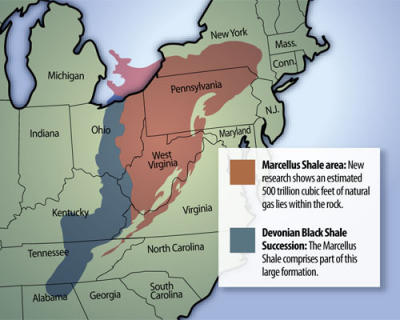Environmental & Economic Interests Clash Over Marcellus Shale
By admin on January 15, 2010
 Environmental groups and proponents of economic development and natural gas exploration are on a collision course of competing economic and environmental interests involving an enormous untapped reservoir of natural gas in the Marcellus Shale Formation. That the Marcellus Shale Formation lies in part across economically depressed regions in upstate New York and Pennsylvania, in urgent need of an economic boost, only adds fuel to the dispute. At the heart of the controversy lies the New York City watershed, pristine waters in upstate New York counties that provide the drinking water for millions of people in New York City. The Marcellus Shale Formation sits underground and stretches southwest from New York through Pennsylvania, and into West Virginia and Ohio. According to experts at Penn State University, the Marcellus Shale Formation is the largest known shale deposit in the world. Recently developed extraction techniques in horizontal drilling and hydraulic fracturing are expected to provide an additional boost to the productivity of Marcellus gas wells. Terry Englander, a geoscience professor at Penn State University, estimates that recoverable reserves in Marcellus Shale could be as high as 489 trillion cubic feet! The Draft 2009 New York State Energy Plan recognizes the great potential benefit to New York from development of the Marcellus Shale natural gas resource. But what environmental safeguards should accompany this monumental enterprise?
Environmental groups and proponents of economic development and natural gas exploration are on a collision course of competing economic and environmental interests involving an enormous untapped reservoir of natural gas in the Marcellus Shale Formation. That the Marcellus Shale Formation lies in part across economically depressed regions in upstate New York and Pennsylvania, in urgent need of an economic boost, only adds fuel to the dispute. At the heart of the controversy lies the New York City watershed, pristine waters in upstate New York counties that provide the drinking water for millions of people in New York City. The Marcellus Shale Formation sits underground and stretches southwest from New York through Pennsylvania, and into West Virginia and Ohio. According to experts at Penn State University, the Marcellus Shale Formation is the largest known shale deposit in the world. Recently developed extraction techniques in horizontal drilling and hydraulic fracturing are expected to provide an additional boost to the productivity of Marcellus gas wells. Terry Englander, a geoscience professor at Penn State University, estimates that recoverable reserves in Marcellus Shale could be as high as 489 trillion cubic feet! The Draft 2009 New York State Energy Plan recognizes the great potential benefit to New York from development of the Marcellus Shale natural gas resource. But what environmental safeguards should accompany this monumental enterprise?
On December 23, 2009, the New York City Department of Environmental Protection (“DEP”) (not to be confused with theNew York State Department of Environmental Conservation or "DEC"), called for a prohibition on natural gas drilling in the New York City watershed, urging that, “[N]natural gas drilling and exploration are incompatible with the operation of New York State’s unfiltered water supply system and pose unacceptable risks for more than nine million New Yorkers in this City and State.” According to DEP’s Final Impact Assessment Report, drilling in the watershed requires invasive industrialization and would create a substantial risk of chemical contamination and infrastructure damage. In particular, the DEP’s report singled out the high-volume hydrofracking and horizontal drilling as posing significant environmental risks. Clearly, measures will be taken to protect the watershed, but the devil will be in the details. A Congressional Research Service report, released on September 9, 2009, examines gas drilling in the Marcellus Shale region. The report acknowledges that groundwater contamination from improper drilling and casing is a risk. Water sources in New York listed as "primary" or "principal" aquifers may be at risk, according to the report, due to the permeable "unconsolidated sand and gravel deposits" in northern Pennsylvania and southern New York because of short distances from the land surface to the water table.
